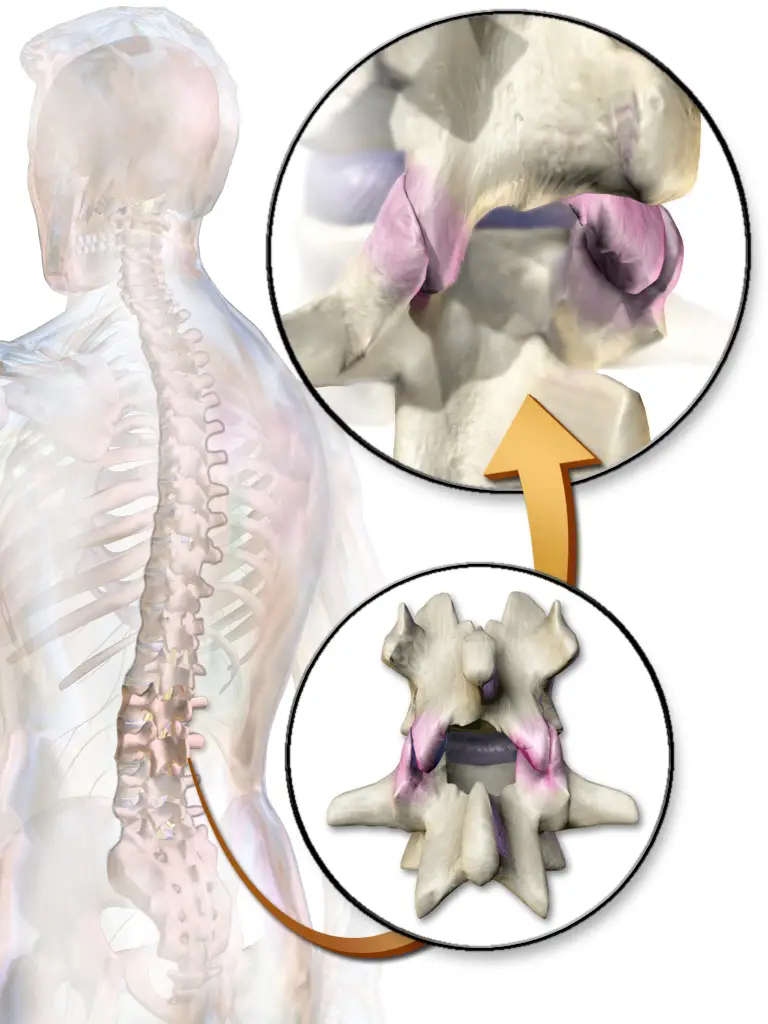If you’re looking for a way to ease your facet syndrome pain, you might want to try inversion therapy. This type of therapy involves hanging upside down, which can help to take the pressure off of your facet joints.
Contents
What is Facet Syndrome?
Facet syndrome is also sometimes called facet joint syndrome, facet joint pain, or facet disease. It’s a type of degenerative joint disease, which means it gets worse over time. It’s a common cause of chronic back pain, and it can be very difficult to treat.
There are many possible causes of facet syndrome. It can be caused by wear and tear on the joints from aging, injury, or overuse. It can also be caused by arthritis or other degenerative changes in the joints. In some cases, it may be caused by bone spurs or other growths on the joints.
Symptoms of facet syndrome vary from person to person. Some people only experience mild pain, while others may have severe pain that limits their ability to move or perform everyday activities. Other common symptoms include stiffness, numbness, tingling, weakness, and headaches.
The diagnosis of facet syndrome is usually based on a physical examination and a review of your medical history. Your doctor may also order imaging tests such as x-rays or MRI scans to look for signs of damage to the facet joints. In some cases, diagnostic blocks or other types of testing may be necessary to confirm the diagnosis.
There is no cure for facet syndrome, but there are treatments that can help relieve the pain and other symptoms. Conservative treatments such as physical therapy and medication can be helpful for some people. In more severe cases, radiofrequency ablation or surgery may be necessary.
Relieve Pain from Facet Syndrome with Inversion Therapy
Facet syndrome is a condition affecting the joints of the spine. The Facet joints are small, but they play a big role in keeping the spine functioning properly. When these joints become damaged, it can lead to a number of painful symptoms.
Inversion therapy is one of the most studied-backed natural solutions for facet syndrome. Inversion therapy involves hanging upside down from an inversion table or other similar device. This position takes the pressure off of the joints and allows them to heal naturally.
In a recent study, patients with facet syndrome who underwent inversion therapy saw a significant reduction in pain and an improvement in function. In addition, patients who started inversion therapy early on in their condition saw the greatest benefit.
This suggests that inversion therapy may even provide a head start on healing for those with facet syndrome. If you suffer from facet syndrome, talk to your doctor about whether inversion therapy may be right for you.
What Are the Common Causes of Facet Syndrome?

Facet syndrome is a condition that results when the facet joints in the spine become irritated or inflamed. Facet joints are the small joints in the back of the spine that allows the vertebrae to move.
There are two ways that facet syndrome can develop. The first is age. As we age, the cartilage between the facet joints begins to degrade. This can lead to friction and irritation when the facet joints move.
The second way that facet syndrome can develop is through repetitive movements or unnatural posture. This can happen from activities like lifting heavy objects or from sitting in one position for too long.
When the facet joints are forced into these positions, it can lead to inflammation and pain.
The symptoms of facet syndrome include pain in the back, hips, and legs, stiffness, and difficulty moving. The pain is usually worse with activity and gets better with rest.
If you think you may have facet syndrome, it’s important to see a doctor so they can diagnose and treat your condition.
Ways to Relieve Pain from Facet Syndrome
Facet syndrome is a condition that affects the small joints in the spine, called facets. These joints allow the spine to move and provide stability. When they become damaged or inflamed, it can lead to muscle pain and stiffness.
There are a number of ways to relieve pain from facet syndrome, including inversion therapy and less invasive techniques such as positive behavior modifications and improved body mechanics. Inversion therapy involves hanging upside down to increase blood flow and stretch the muscles. This can be done using an inversion table or by hanging from a bar.
One of the most important things you can do to relieve pain from facet syndrome is to make deliberate daily choices that will improve your condition. These include things like staying active, maintaining a healthy weight, practicing good posture, and avoiding activities that aggravate your pain. Making these changes can help reduce the amount of stress on your facet joints and help relieve pain.
Learn How Inversion Therapy Relieves Pain from Facet Syndrome
Inversion therapy is a treatment that involves hanging upside down, or at an inverted angle, to stretch the spine and relieve back pain. Facet syndrome is a type of degenerative joint disease that affects the facet joints in the spine.
These joints are located between the vertebrae, and they allow the spine to move freely while still providing support and stability. When these joints become damaged or degenerative, they can cause pain, stiffness, and loss of mobility.
A study published in The Journal of Pain found that inversion therapy may be an effective treatment for patients with facet syndrome. In the study, 30 patients with facet syndrome were divided into two groups.
One group received inversion therapy using an inversion table, and the other group received standard medical care. The patients who received inversion therapy showed significant improvement in their pain levels compared to those who did not receive this treatment. In addition, the patients who received inversion therapy were also more likely to have a reduction in their use of pain medication.
If you are interested in trying inversion therapy for your facet syndrome, you can purchase an inversion table or a teeter inversion machine from a medical supply store or online retailer.
You should always consult with your doctor before beginning any new treatment, especially if you have a medical condition or are taking medication.
Learn More About Teeter Inversion Tables
Facet syndrome is a condition that causes pain in the joints of the spine. It is thought to be caused by the wearing down of the cartilage that cushions the bones in the joints. Inversion therapy is a type of treatment that uses gravity to stretch and decompress the spine.
Teeter is a leading manufacturer of inversion tables and other medical devices. A recent study found that patients with facet syndrome who used a Teeter inversion table for 10 minutes per day experienced significant reductions in pain and improvements in function.
If you suffer from facet syndrome or other pain-related conditions, teeter gravity-assisted inversion may be an effective treatment option for you. Talk to your doctor about whether teeter inversion tables are right for you.
Why Using Teeter Inversion Tables Is the Right Choice
If you suffer from facet syndrome, you know how much pain it can cause. Traditional treatments like pain medication and physical therapy can help, but they often come with side effects and can be expensive. That’s why more and more people are turning to inversion therapy as a safe, affordable way to relieve their pain.
Inversion therapy involves hanging upside down or at an inverted angle for a short period of time. This can help decompress the spine, take pressure off of the facet joints, and improve blood flow to the affected area.
There are many different brands of inversion tables on the market, but Teeter is by far the leader in quality and customer satisfaction. Teeter tables are built with safety in mind, and their easy-to-use design makes them a great choice for people of all ages and fitness levels.
Some of the many benefits of using Teeter inversion tables include:
- Relief from sciatica back pain, neck pain, and headaches
- Improved circulation
- Reduced inflammation
- Increased mobility
- Greater flexibility
- Improved spinal alignment
Teeter inversion tables are easy to set up and use, and they can be folded up for easy storage when not in use. Most models also come with a risk-free 60-day satisfaction guarantee, so you can try out the table with no commitment.
So if you’re looking for a safe, effective way to relieve your facet syndrome pain, look no further than Teeter inversion tables. With their many benefits and satisfied customers, Teeter is the clear leader in the inversion table market.
Frequently Asked Questions
How do you fix facet syndrome?
Facet syndrome is a condition that affects the small joints in the back of the spine. The facet joints are the joints that connect the vertebrae, and they allow the spine to move. Facet syndrome occurs when these joints become inflamed or irritated. The symptoms of facet syndrome include pain and stiffness in the back and neck. Treatment for facet syndrome includes over-the-counter pain medication, physical therapy, and injections.
Can facet syndrome be cured?
There is no known cure for facet syndrome. However, there are treatments that can help manage the pain associated with the condition. These include physical therapy, pain medication, and steroid injections.
What are the symptoms of facet joint syndrome?
The symptoms of facet joint syndrome include pain and tenderness in the facet joint area, as well as stiffness, decreased range of motion, and inflammation.
inversion therapy, facet joints, facet syndrome, joint syndrome, inversion table, physical therapy, pain relief, facet joint pain, facet joint, back pain, lumbar spine, joint pain, degenerative changes, inversion tables, USA spine care, blood flow, spinal decompression therapy, medial branch, facet syndrome treatment, treatment options, syndrome treatment, spinal cord, facet pain, joint injections, neck pain, physical therapist, spinal nerve, physical examination, lumbar facet syndrome, spine physicians, facet arthropathy, abdominals, low back pain, l4, chronic back pain, spinal fusion, z-joints, spinal surgery, pain medicines, facet joint arthritis, invasiveness, sacral, spinal nerve, sacralization, spondylosis, lumbosacral transitional vertebra, open surgical, laminectomy, facet syndrome, lumbar, minimally invasive spinal surgery, herniation, degenerative disc disease
Conclusion
Inversion therapy has a long history, going back to at least the last century. It was originally developed as a traction device to be used in hospitals for patients with back pain. Over the years, traction machines have been replaced by inversion devices such as inversion tables and chairs.
There are many old drawings of people being inverted for traction, but there is little scientific evidence to support the use of inversion therapy for facet syndrome.
Some patients do report relief from their symptoms after a few days of traction, but there is no guarantee that the relief will last. In addition, there is a risk of flare-ups if the traction is not used properly.
If you are considering inversion therapy for facet syndrome, it is important to speak with your doctor first. In addition, be sure to use only FDA-approved inversion devices and follow all safety instructions carefully.

Dave Lee is the founder of Spine Institute NY, a huge fan of inversion therapy, a researcher, and an author.

